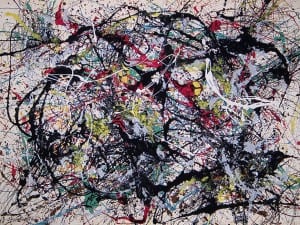Currently housed within the top floor gallery of the Tate Liverpool the visitor finds an extensive collection of work relating to left-wing movements and ideology. Common to all work here therefore is the conviction that people working together in concert is better than people working individually. Continuous throughout is evidence of the belief in the equality of all people. These sentiments, it is evinced, are engaged in a quest for social progress in relation to economic systems.
A relationship between these commonly held ideas is naturally drawn across to the nature of the canon of Western art history. We are familiar with the operation of this canon, in which individuals are held up as ground breaking geniuses (usually male) that expand the limitations of artistic media. In Art Turning Left the resultant individual gain and establishment of hierarchies is highlighted.
Exhibited in at least one section of this collection the visitor finds works that particularly run counter to this tendency. Collective production without individual authorship was one of the aims of The Guerilla Girls. Several works are exhibited by this anonymous collective, which address the inequalities of the art world. This work ought to be lauded highly for the aesthetic employed. The viewer finds great stylistic continuity throughout. The messages transmitted are complex. However, the regularity of style in all depictions is highly appealing for its illustrative simplicity and would be the sort of thing that might prove popular. It is fresh, and its potential for popularity is a quality ironically lacking in quite a lot of the work exhibited in Art Turning Left.
Work by El Lissitzky can be found. It is bold and geometric with that stylised regularity the viewer might expect of a Soviet-approved style. In the vein of ‘Art for Everyone’, works are exhibited relating to political defiance. Militancy is suggested strongly. Work by Spanish collective, Equipo 57, is presented. Bold and quite cheerful colours are employed as roughly cut, interlocking sections strike the viewer in two dimensions. The cheerfulness of the colours might have provided some of the necessary stylistic escapism and razzmatazz combined with political message to be effectively appealing. This does not succeed as well as those works already mentioned by The Guerilla Girls.
Personally resonant, and likely to be resonant for many others was the large-scale exhibit of The Workers’ Union flag. While stirring emotion the pictorial design is somewhat reminiscent of the print work of William Blake.
The question is raised: how can art infiltrate everyday life? The response of this exhibition is to show how it need not necessarily be confined to an elite. Clothing design and advertisements are given prominence here with pleasing familiarity. The question of Public Participation is raised. Collaboration with the public is often part of the early stages of an artwork. Artworks in which the public have participated on an equal footing throughout can be found here. The question of whether the pursuit of equality can change how art is made is raised. William Morris is suggested as an example of the production of artwork made creatively on an equal footing.
Along with the work of The Guerilla Girls, the most successful examples of art produced with both a left wing message but with likely broad appeal are a series of photographs. These photographs capture craft work and artwork produced and intended to participate in local traditions. These are both charming and serious.
Daniel Potts
Art Turning Left, 8 November until 2 February, Tate Liverpool, Albert Dock, Liverpool Waterfront, L3 4BB. www.tate.org.uk/visit/tate-liverpool
Credits:
1. Guerrilla Girls, [no title] 1985–90, © Courtesy www.guerrillagirls.com
2. Cildo Meireles, Insertions into Ideological Circuits: Coca-Cola Project 1970, © Cildo Meireles




